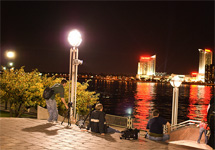MLUI / Articles from 1995 to 2012 / Are the Stars Lining Up for Detroit?
Are the Stars Lining Up for Detroit?
State policy, foundations, new mayor could signal historic turnaround
October 18, 2010 |
Great Lakes Bulletin News Service
 | |
| MLUI | |
| The S.S. Kresge Foundation provides major funding for the restoration of Detroit’s riverfront, one of the city’s key assets. |
Part Three of a five-part series
Detroit has many fine things going on, and many fine actors that are working hard for the future of the city. Even better, some of their efforts center on ideas and principles that are “out of the box.”
The plans many community leaders are making match many of the directions that experts nationwide seem to agree are pathways to the New Economy. Foundations also seem to be reaching consensus about these pathways, and are increasingly supporting them with dollars.
For example, the Community Foundation for Southeast Michigan has obtained funds from a consortium of foundations to lead a project called the New Economy Initiative for Southeast Michigan. The organization will direct money to projects that better ground Detroit and the region in the New Economy. That kind of funding alone is a most significant testament to the new, emerging view on the future and prospects of the greater Detroit region.
Another good sign: Last year, Dave Bing won the mayoral election and came into office with a mandate to stage what would be the biggest turn-around ever of a major city. His administration has quickly taken some very bold steps in articulating ways forward.
For example, with the help of foundations, his administration commissioned a consulting group to help drive Detroit’s future land use plans. The city also engaged McKinsey & Company to help with the vision piece.
All of this is good news, considering that, until recently, the level of optimism about Detroit was rather low. Getting everyone to play from the same sheet of music has always been a challenge in Motown. So when great minds from the public, private, and foundation sectors start to believe that good things can happen in Detroit, there is a very good chance that they will.
Better yet, all of these recent developments match the direction of state policy, which is increasingly comfortable with public support for revitalizing cities. The State of Michigan is rapidly warming up to the idea that the success of Detroit is critical to the success of the Detroit metro region, and that the success of the region is a prerequisite for Michigan’s return to prosperity.
Governor Jennifer Granholm’s Cool Cities initiative and Cities of Promise program are early examples of creative thought by elected leaders about the importance of cities. However, those ideas were slow to resonate statewide. Today, though, there seems to be more universal acceptance of the idea that cities are important and that positioning Detroit well for the future is also important.
And, it should be added, both gubernatorial candidates—Republican Rick Snyder and Democrat Virg Bernero—say that reviving our large cities is crucial to Michigan’s success. Mr. Bernero is the mayor of Lansing, and Mr. Snyder has indicated he supports smart growth principles.
But these current and potential future opportunities to position Detroit come at a time when the city and the state are both economically challenged. So, while it appears that the policy community is finally getting it, we have limited state and local resources to make things happen.
That is why, in moving Detroit forward, we must look to the feds for any assistance we can get. Fortunately, that is already happening.
In fact, many of Detroit’s new, emerging initiatives seem highly consistent with the direction of current federal policy and funding opportunities, thanks largely to the American Recovery and Reinvestment Act (ARRA). Huge federal funds are now available for initiatives with such titles as “Neighborhood Stabilization Program,” “Choice Communities,” “Sustainable Communities,” “Advanced Transportation,” “Renewable Energy,” and “Workforce Development.”
And there are more opportunities beyond the ARRA budget, including a large amount of federal funding for education, transportation, roads, parks, trails, and energy. So, if Detroit is visionary and is competitive in attracting federal dollars, it can lay a strong foundation for the future while leveraging federal resources.
Paying attention to where the city, its administration, the people of Detroit, the foundation community, the state and Washington, D.C. are going leads many of us to conclude that there are promising new possibilities taking shape in our largest city.
These are all reasons why I believe the stars are lining up for Detroit and that this is the time to act.
So it makes sense for Detroit to be true to itself, ignore “cookie cutter” models, and build a future based on its inherent critical assets.
Those assets will be the subject of the next article in the series.
Dr. Soji Adelaja is the John A. Hannah Distinguished Professor in Land Policy and director of the Land Policy Institute at Michigan State University. This article was first published by LPI on Sept. 17, 2010, and is used by permission. Read Part One of this five-part series here, and Part Two here.





